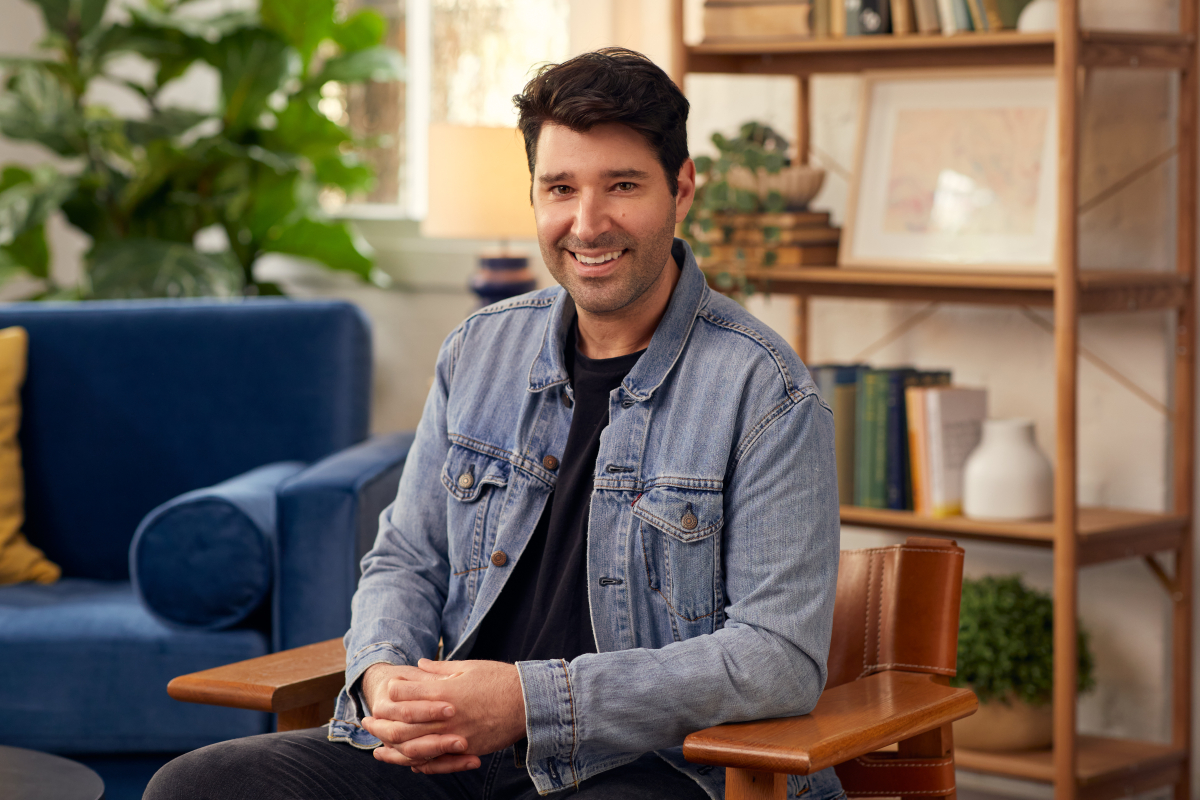“I still don’t understand what Web3 is”
We meet Cliff Obrecht, Canva Co-Founder and COO, at a press event in London. Obrecht traveled from their native Australia to the British capital together with his wife and co-founder Melanie Perkins to inaugurate the first European Canva campus in London and to present new AI tools for the design platform.
Canva was founded in 2013 with a mission to democratize design and make design accessible to all. Around 135 million people worldwide now use Canva to create their social media posts, birthday cards or presentation templates every month – around ten percent of them (14 million) are paying customers.
How big Canva has become becomes clear when we ask Obrecht how he manages to maintain a healthy company culture despite the massive growth. Instead of talking about the hiring process, he explains how Canva acquires companies.
The recent Canva acquisition from the year 2022 is Flourish. With the features of Flourish, which have been part of the Canva platform since May, users should be able to visualize data and create statistics even more easily. Also two German companies Canva has already swallowed: Pexels from Fuldabrück and Pixabay from Munich.
Nevertheless, the founders are far from satisfied. “We’re still only one percent of the way there,” said Melanie Perkins in the previous press conference. We asked Cliff Obrecht what that means.
t3n: Canva aims to make design accessible to everyone. Does that mean that the profession of designer will then be on the brink of extinction?
Obrecht: We’ve been having this discussion for years. I don’t believe. Design just evolved.
When you talk to designers today, most of them are grateful for Canva. Ten years ago, for example, a designer would have had to customize each and every one of business cards – changing names and phone numbers is crappy work for a designer.
Today, a:e designer:in only designs the layout of the business card and puts a dummy text like “Lorem ipsum” on it. Other people can then do the personalization. The same goes for sales presentations.
“In our experience, tools like Canva now enable designers to do more of the work they love.” – Cliff Obrecht
In our experience, tools like Canva now enable designers to do more of the work they love, which is high-quality creative work. You create the central content, which can then be easily scaled in the company.
t3n: Many of your templates are created by external designers. How does the collaboration with these creatives work?
Obrecht: We have tens of thousands of contributors and we also need them for localization.
For example, Europe alone consists of over 40 different cultures, languages and so on. In order to be able to respond to the respective stylistic preferences, it is essential for us to work together with local design communities.
Only when we are able to geographically tailor the content and product experience to each of these unique cultures can we be successful.
t3n: Do you have an example of the different preferences of users in different countries?
Obrecht: Take something everyday like drinking a cup of coffee, for example. This usually looks very different in Turkey than in Paris. The people look different, the environment looks different, the rituals look different.
So if you’re a user in Paris and search Canva for a template for a person drinking coffee, you’ll get different suggestions than if you’re a user in Turkey.
t3n: What was the design landscape like in 2013 when Canva was founded?
Obrecht: When we launched Canva ten years ago, only one percent of internet users were professional designers. Design tools were very complicated and prevented many from designing anything on the computer themselves. If you wanted to design something, you needed half a degree in the usual design programs.
The three Canva founders: Cameron Adams (left), Cliff Obrecht and Melanie Perkins. (Image: Canva)
But people have always been creative. They lived out their creativity through their clothes, their art or their music.
With Canva, we wanted and still want to empower everyone to become a designer themselves and to use technology to communicate visually.
t3n: We are seeing an increasing shift towards visual content and video. Children read less and less. What do you think about the development of text?
Obrecht: Different content requires different methods of communication. In the past, you were forced to work mostly text-based because the design tools got in the way. Now you have a choice. I still enjoy reading some documents. Not everything has to be graphic.
t3n: Form follows function as Dieter Rams said?
Obrecht: Exactly. An in-depth analysis for a corporate strategy or investigative journalistic work usually works better in text form. Statistics, on the other hand, can often be presented better in a graphic. It depends on the preferences and content.
t3n: In March 2023 they have with the “Magic” line of new AI tools introduced. What were the biggest challenges during implementation?
Obrecht: We tend to think in terms of opportunities rather than challenges. Technology is changing incredibly fast. Fortunately, in 2021 we already took over the AI company Kaleido from Vienna, whose entire competence lies in the field of photo editing, photo creation and visual AI.
This positioned us very well to integrate these new models, technologies and algorithms into our Canva ecosystem, and was able to offer tools such as text-to-image generation at scale early on.
Editor’s Recommendations
t3n: What about copyrights?
Obrecht: We’re strong believers in copyright and want to make sure the AI we use is trained on legitimate datasets. We want to make sure everyone who contributes to these AI systems is rewarded fairly.
t3n: A few videos have gone viral on Tiktok in which people use Canvas Magic tools to change their entire outfits and backgrounds. How do you perceive the social media response?
Obrecht: Our AI tools are indeed impressive. They did something similar for me when we opened our new Canva campus in London. They used Canva to dress me up in a Beefeater – I always thought it was gin, but that’s the London uniform for government officials. That was funny. But yeah, it’s gone crazy on Tiktok.
“It’s gone crazy on Tiktok.” – Cliff Obrecht
t3n: How do you ensure that people don’t misuse your technology, for example to create deep fakes?
Obrecht: You can’t really create deep fakes in Canva. “Voice matching”, i.e. the generation of voices, is also not possible. We consider it our responsibility not to allow these opportunities to prevent fraud and abuse. In some respects we are probably even too restrictive.
For example, we don’t allow people to be created. You can change a picture’s background or a person’s clothing, but you can’t create an avatar that looks like a specific celebrity. We have also made restrictions on the permitted search terms. For example, we don’t want Canva to create anything political.
We want to be on the right side of history. We are therefore careful and adhere to ethical principles. Because we know that with great power comes great responsibility.
We also make many of the tools we develop for ethical AI open source. We want everyone working with AI to be able to use the ethical tools we’ve invested in.
t3n: How big is your team of AI specialists and ethicists?
Obrecht: There are around 100 people who deal specifically with AI. The broader team is probably twice as big again. I don’t know the exact numbers of the ethics team, but there are several dozen people from different disciplines – engineering, law, user experience, design. It’s a focus area for us.
t3n: Who do you see as your biggest competitor, now and in the future?
Obrecht: When we started Canva ten years ago, we had virtually no competition – except for professional designers.
In the last decade, the competitive landscape has changed as other companies have entered visual communications. But we have the feeling that with our ten-year lead in this area, we are also well positioned for the next ten years.
We don’t really look at the competition, but much more at what we can further democratize, what we can do better. And as Melanie already said: We have only achieved one percent of what we intend to do.
t3n: Do you want to increasingly become a B2B service with the help of your new tools, such as the Flourish integration?
Obrecht: One hundred percent. Increasingly, we want to work with companies and position Canva as the official company tool for visual communication.
t3n: You invested in AI early on. What about the Web3 and Metaverse areas?
Obrecht: I still don’t understand what Web3 is. I googled it, read about it and some people tried to explain it to me but I still don’t really get it. So no, the Metaverse isn’t a focus for us right now.
However, what I see is that the blockchain and also NFT have great value, for example when it comes to copyrights. That can be integrated. But I wouldn’t compare Web3 or NFT to anything like the AI revolution.
I think AI is a fundamental technological change, like the mobile phone. Web3 and NFT are just distractions for me.



